|
Carlby bridge
BUILT 1859
|
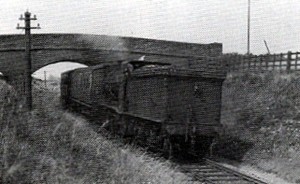 |
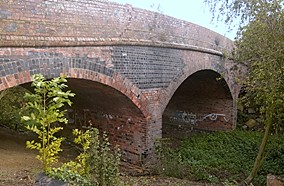 |
|
The bridge pictured in 1950 when the line
was in use and again in 2006 after
being earmarked for demolition |
Relics of the steam age can be found
in many places around the country and as Bourne was an important railway
centre for more than 100 years, disused stations, bridges, viaducts and
sidings remain as a reminder of the popularity of this form of transport
for passengers and freight.
Among them is the road bridge over the disused line between Carlby and
Greatford, four miles south west of Bourne, built in 1859 as part of the
new rail link with Essendine, so connecting with the main east coast line
between London and the north.
Bourne station was then located next to the Red Hall and the line ran
through Thurlby, Wilshorpe Halt, Braceborough Spa and on to Essendine, all
villages which retain distinctive remains of the railway age such as red
brick station houses, concrete platforms and whitewashed gatekeepers’
cottages.
The Bourne and Essendine Railway Company was founded to build the line in
1857, headed by such distinguished people as the wealthy landowner John
Lely Ostler and the vicar, the Rev Joseph Dodsworth, who between them
provided the £48,000 share capital needed to finance the project. A total
of 54 acres of land was bought for the track which was to run for a
distance of 6¼ miles with no major embanking or cutting work required and
when the parliamentary bill for its construction was finally approved by
the House of Lords in July that year, the bells of the Abbey Church were
rung in celebration and it was announced that work would begin immediately
the harvest had been completed when sufficient local labour would be
available.
Consignments of bricks and sleepers began arriving before Christmas and
were stored at various sites along the route and orders were placed for
the iron rails. Mr Charles Eldred of Bourne was appointed contractor but
there were delays in raising all of the required capital and work did not
actually begin until the middle of 1858 with a prediction that it would be
completed in 12 months. But this was an optimistic assessment and it was
not until February 1860 that the first train steamed into Bourne station
although this was an experimental run by engineers but a sufficient cause
for celebration because Mr Dodsworth with his wife, daughter and guests,
made an uncomfortable journey on the footplate to Essendine and back,
reaching speeds of 40 mph at some points along the route.
A formal check by a government inspector was still required and the vital
certificate allowing passengers to be carried did not arrive for several
more weeks but services eventually began at 9 am on Wednesday
16th May.
Trains continued to use the line for the next ninety years but by the
mid-20th century, rail travel had begun to decline with fewer passengers
and less freight and in April 1951, despite objections from Bourne Urban
District Council, closure plans were announced. The last train was the
8.51 pm from Essendine to Bourne on Saturday 16th June, packed to capacity
with passengers standing shoulder to shoulder, children hanging out of the
windows, streamers and flags flying bravely and exploding detonators
placed on the line by railway workers sounding the death knell all the way
from Essendine to Carlby bridge.
Within weeks, contractors moved in to start
dismantling the line and its ancillary buildings and fittings, the sidings
in Thurlby station yard being the first to go followed by all redundant
stores down to the last sweeping brush and signal lamp. Sections of the
now disused track bed were sold off to local farmers and soon the line was
little more than a memory.
For the next fifty years, the Victorian two-arch bridge over the road
between Carlby and Greatford was one of the remaining railway relics along
the line although the track bed was soon overgrown and there was no indication that the railway ever ran there
while
sections of the cutting on either side were soon being used as a rubbish
tip. Eventually, the bridge was condemned as unsafe and the
hump it created in the roadway a danger to traffic and despite protests
from the two parish councils which wanted it preserved as part of our
industrial heritage, it was demolished in April 2007 when the road was
closed for three weeks to enable the work to proceed.
All
objections were overruled by South Kesteven District Council’s planning
committee and the British Railways Board which owns the bridge was given permission to remove it because further maintenance
would be uneconomical and so the road at this point was levelled and
the embankment beneath filled in with the red bricks recycled from the
demolition. “We cannot simply maintain structures of
this type when they are no longer in use by rail traffic”, said a
spokesman.
The demolition angered residents in both Greatford and Carlby who claimed
that the bridge had historical merit and had become a haven for wildlife
which had now been destroyed.
|
THE DEMOLITION OF CARLBY BRIDGE
Photographs courtesy Jonathan Smith |
|
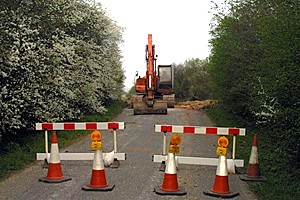 |
 |
|
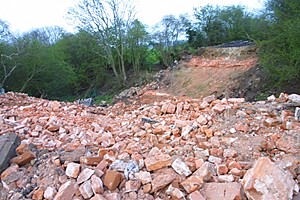 |
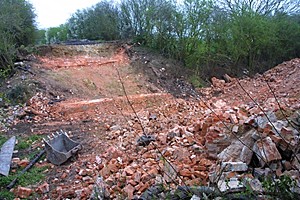 |
REVISED
APRIL 2007
NOTE: Colour photograph of Carlby bridge
courtesy the Stamford Mercury
Return to
Railways
Carlby

Go to:
Main Index Villages
Index
|




